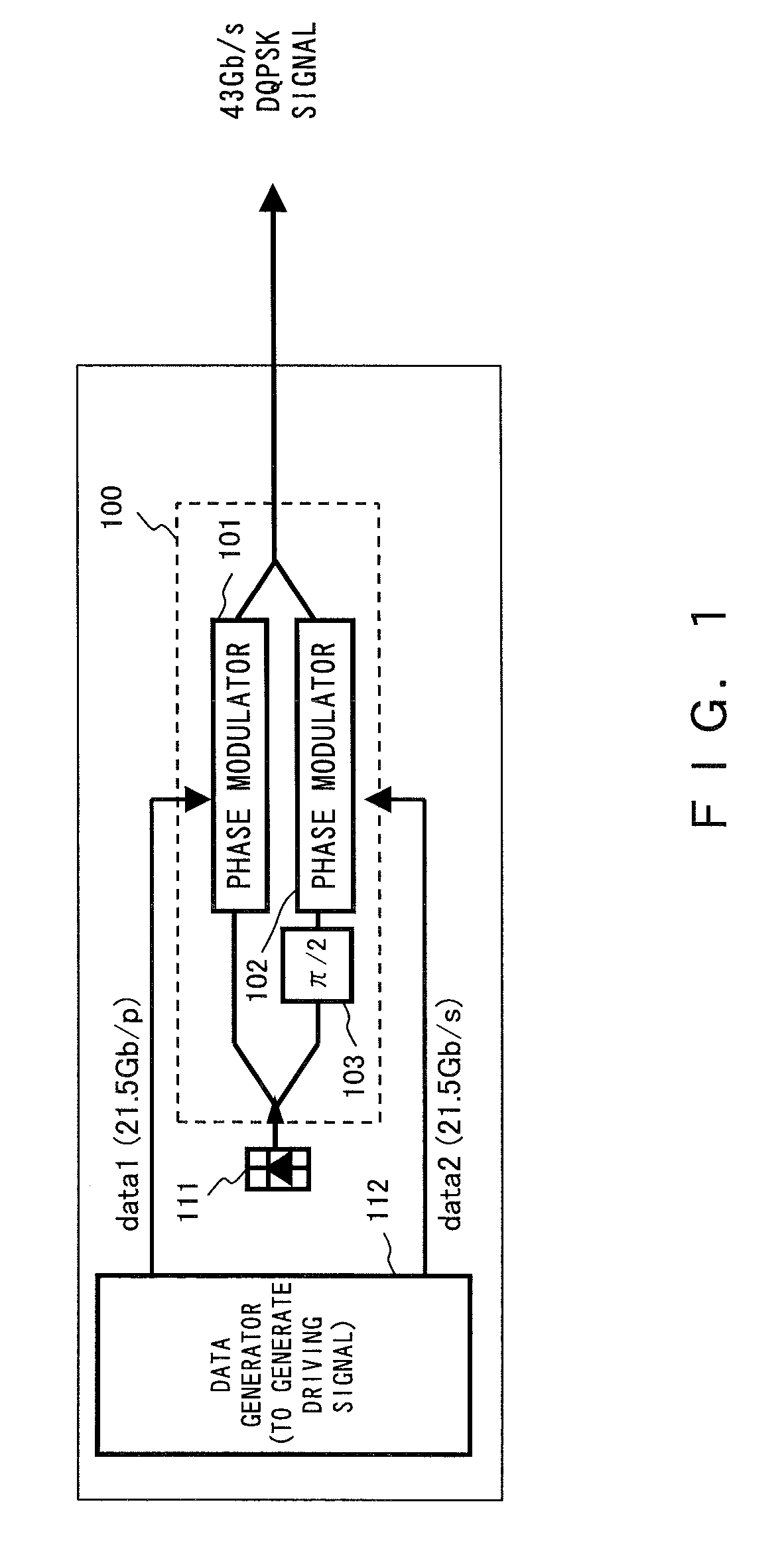Optical transmitter apparatus
- Summary
- Abstract
- Description
- Claims
- Application Information
AI Technical Summary
Benefits of technology
Problems solved by technology
Method used
Image
Examples
first embodiment
[0051]FIG. 5 is a diagram describing the configuration of an optical DQPSK transmitter apparatus of the first embodiment. The optical DQPSK transmitter apparatus of the first embodiment provides a function for adjusting the amplitude of a driving signal based on the power of the optical RZ-DQPSK signal generated by the RZ intensity modulator 30. In FIG. 5, descriptions of the clock generator unit 112 and the data generator unit 113 are omitted.
[0052] The photodetector 31 converts the optical RZ-DQPSK signal output from the RZ intensity modulator 30 into an electrical signal (hereinafter referred to as a “monitor signal”). A capacitor C removes a DC component from the monitor signal obtained by the photodetector 31. By so doing, an AC component of the optical RZ-DQPSK signal is extracted. An amplifier 41 amplifies the monitor signal from which the DC component is removed. A power detector unit 42 detects power of the monitor signal amplified by the amplifier 41. The power of the mon...
second embodiment
[0066]FIG. 9 is a diagram describing the configuration of the optical DQPSK transmitter apparatus of the second embodiment. The optical DQPSK transmitter apparatus of the second embodiment provides a function for adjusting the DC bias of each of the phase modulators 13 and 14 in the optical DQPSK modulator 10, based on the power of the optical RZ-DQPSK signal generated by the RZ intensity modulator 30. Note that the descriptions of the clock generator unit 112 and the data generator unit 113 are omitted.
[0067] In FIG. 9, the monitor unit (i.e. the photodetector 31, the capacitor C, the amplifier 41 and the power detector 42) is basically the same as that of the first embodiment. In other words, the monitor unit detects the power of the optical RZ-DQPSK signal and generates a monitor signal.
[0068] A minimum power detector unit 51 and a bias adjuster unit 52 adjust the DC bias for adjusting the operation point of the phase modulators 13 and 14 so that the power of the monitor signal...
third embodiment
[0077]FIG. 14 is a diagram describing the configuration of the optical DQPSK transmitter apparatus of the third embodiment. The optical DQPSK transmitter apparatus of the third embodiment comprises a function for adjusting the amount of phase shift of the phase shifter 15 of the optical DQPSK modulator 10 in addition to the DC bias control function of the second embodiment.
[0078] A control unit 60 provides the DC bias control function and the phase shift amount adjusting function based on the power of the monitor signal obtained by the power detector unit 42. Here, the control unit 60 is realized by a CPU, for example, executing a prepared program. A gain adjuster unit 61 is the same as the minimum power detector unit 51 and the bias adjuster unit 52 shown in FIG. 9.
[0079] The amount of phase shift of the phase shifter 15 has to be accurately adjusted at π / 2, as stated above. The amount of phase shift of the phase shifter 15, particularly in this embodiment, is adjusted by the DC ...
PUM
 Login to View More
Login to View More Abstract
Description
Claims
Application Information
 Login to View More
Login to View More - R&D
- Intellectual Property
- Life Sciences
- Materials
- Tech Scout
- Unparalleled Data Quality
- Higher Quality Content
- 60% Fewer Hallucinations
Browse by: Latest US Patents, China's latest patents, Technical Efficacy Thesaurus, Application Domain, Technology Topic, Popular Technical Reports.
© 2025 PatSnap. All rights reserved.Legal|Privacy policy|Modern Slavery Act Transparency Statement|Sitemap|About US| Contact US: help@patsnap.com



